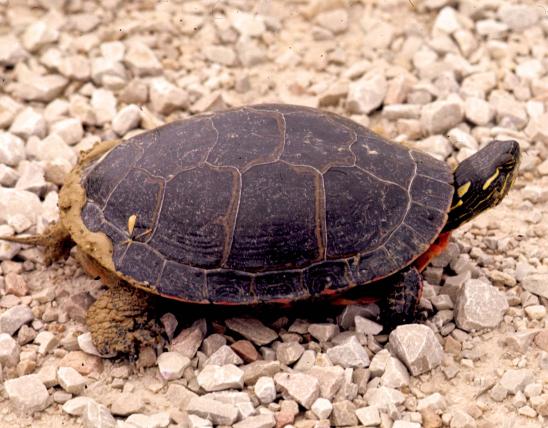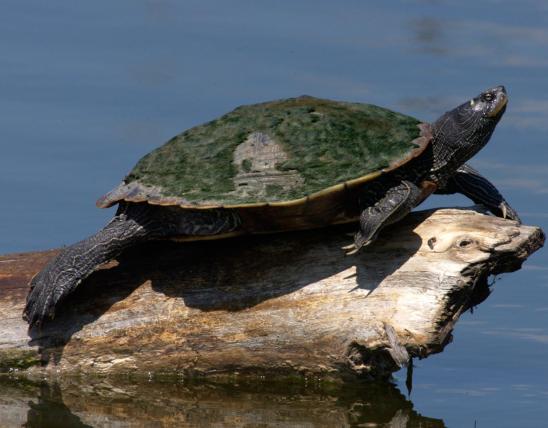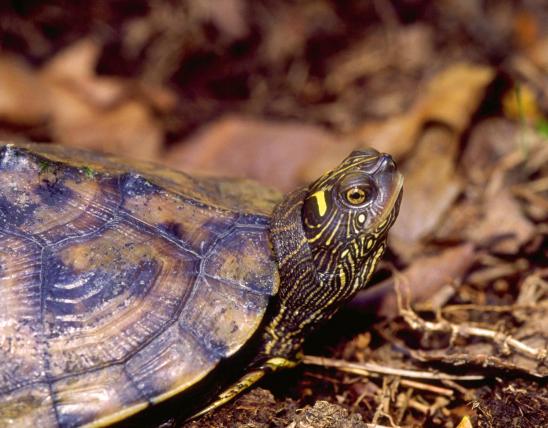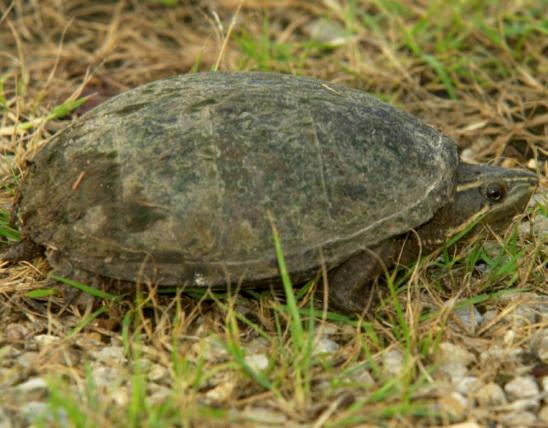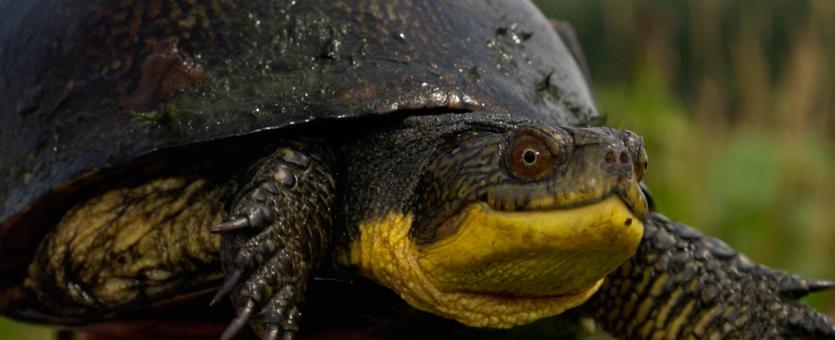
Blanding's turtle is a medium-sized turtle with an oval, moderately high-domed carapace (upper shell) and a long head and neck. The upper shell is dark brown or black with many yellow spots or bars. The plastron (lower shell) is brown fading to yellow with large brown or black blotches on the outer portions of each scute (shell scale); the forward third of the plastron is hinged and movable. The exposed skin is brown and yellow. The upper jaw may be marked with black pigment in a pattern that resembles a mustache. The underside of the head and neck is bright yellow.
Similar species: Several other members of the Emydidae (the pond and box turtle family) occur in Missouri. Keep in mind that Blanding's turtle is rare in our state and is restricted to the northeast and northwest corners. Not counting box turtles, other emydid turtles occurring in one or both of the northern corners of the state are the western painted turtle, northern map turtle, Ouachita map turtle, northern false map turtle, and red-eared slider.
This is the only species in genus Emydoidea.
Adult upper shell length: 6 to 9 inches; occasionally to 11 inches.

In Missouri, this species occurs only in the extreme northeastern and northwestern corners of the state. Three specimens were captured in 1990 and 1991 in St. Charles County; however, no populations have been verified. The overall North American range comprises southern Ontario and extreme southern Quebec, isolated populations in Nova Scotia, New England, and New York, around the Great Lakes states and into Iowa, with peripheral populations in Nebraska, South Dakota, and Missouri.
Habitat and Conservation
This semiaquatic turtle spends a considerable amount of time in shallow water along the edge of wetlands in prairie and grassland habitats. Blanding's turtles frequently move around on land, especially near wetlands. They also bask on logs or muskrat houses. Their yellow throats are visible from a considerable distance.
When captured, a specimen will withdraw into its shell and close the forward part of the plastron tightly against the carapace.
In Missouri, this species is mainly active from late March through October. Habitats used by this species include natural marshes and sloughs, ponds, and drainage ditches. Abundant aquatic and emergent vegetation and a mud bottom are important habitat components. Missouri populations seem to be more aquatic than in other states.
This species overwinters in mud at the bottom of marshes or ponds. Individuals apparently enter their overwintering sites by late October or early November.
Food
The diet of Blanding's turtles in northeastern Missouri consists of crayfish, aquatic larvae of insects, some terrestrial insects, fish, and frogs. A study of Michigan Blanding's turtles showed a similar diet. However, a study in northeastern Illinois, in a wetland where crayfish were not present, found that Blanding's turtles in that area ate primarily snails and aquatic insects.
During the active season, Missouri's populations of Blanding's turtles apparently feed in two phases: between early April and mid-July, and again from mid-August through mid-September.
Status
Listed as endangered in the state of Missouri; it is a Missouri species of conservation concern. This species was first discovered in our state in 1965, in the northeastern part of Missouri. Another population was discovered in northwestern Missouri in 2000.
Blanding’s turtle is listed as endangered in Missouri due to its small populations and reduced natural wetland and grassland habitats. Small but consistent populations continue to exist in Missouri.
The total range of this species is centered on the Great Lakes, but it is listed as endangered in most places it occurs, due to limited numbers, a reduction and fragmentation of natural habitats, and heavy losses from nest predators, road kills exacerbated by human development of rural areas, and a very long generation time (36–47 years).
Life Cycle
In our state, courtship and mating occur mainly in April through early June, although they have also been observed in August in northwestern Missouri. In June, females move overland to select a nesting site with sandy, well-drained soil and good exposure to the sun. These sites may include agricultural fields, levees, or prairies. A clutch of 3–22 eggs is normally laid in June. Hatching occurs in August and into September.
Sexual maturity occurs between 14 and 20 years of age. Blanding's turtles can live well over 40 years. An individual captured in Minnesota was determined to be at least 75 years old.
Human Connections
Although people may think of an animal’s value only in terms of its direct economic imprint on human affairs, the science of ecology shows that each component of the natural community plays a unique and important role. Valuing nature means valuing even the smallest plants and animals.
This species was named in honor William Blanding Jr. (1773–1857), a medical doctor, apothecary, and naturalist born in Massachusetts. He lived in South Carolina and Philadelphia, was a member of the Academy of Natural Sciences, and was an honorary member of the Massachusetts Medical Society.
Ecosystem Connections
Blanding’s turtles help control populations of the relatively small animals they eat. But many predators, including raccoons and foxes, eat them, easily following the turtles’ relatively strong scent trails. The turtles have extra problems where raccoons tend to concentrate near human homes.
Blanding’s turtle is a member of family Emydidae (the pond and box turtle family). This is one of the largest families of living turtles in the world. It comprises 12 genera, containing 52 species. In general, turtles in this family are small to medium sized and are adapted to a variety of habitats. This family includes several colorful species. Although the majority of species are aquatic (such as the eastern river cooter), several kinds are either semiaquatic or have taken to life on land (for example, the box turtles). In Missouri, this family is represented by 7 genera with a total of 11 species and 1 additional subspecies.
























